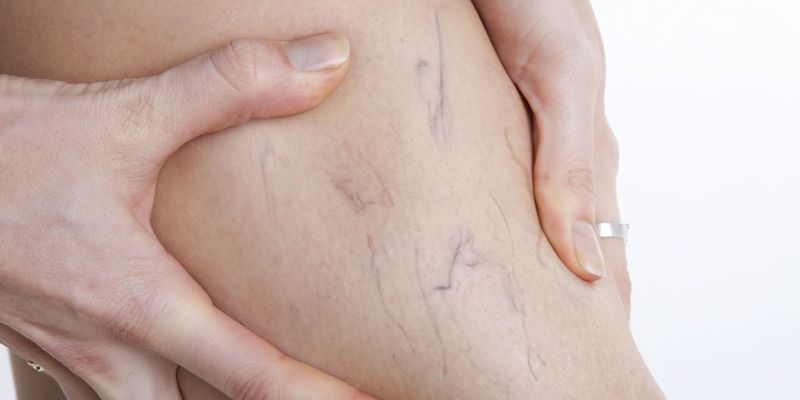Capillaries are tiny blood vessels that carry oxygen and nutrients from arteries to tissues of the body and bring away the wastes. Broken capillaries may also appear on other parts of the body. Normally they seem to be like red or purple marks often like a web of tiny veins under your skin. They are also called spider veins or varicose veins. Broken capillaries on legs form when the blood capillaries dilate for a number of reasons. Here let’s find more about it.

Causes of Broken Capillaries on Your Legs
Inheritance from Parents
Heredity is one major reason of broken capillaries. If your parents underwent broken capillaries, you are likely to have them too. It is something you cannot avoid. Some women are more prone to develop this problem than men.
Hormonal Imbalance
It is also a common cause of broken capillaries. Progesterone and estrogen in high level make the capillaries and veins dilate. Women who are going through hormonal changes because of pregnancy, birth control pills or other estrogen treatments can be more likely to have broken capillaries on legs.
High level estrogen can dilate the capillaries. However, substantial downfall of estrogen and progesterone level can also cause high blood pressures in women. Therefore, broken or ruptured capillaries are very common during menopause.
Pregnancy
Besides of causing hormonal imbalance, pregnancy can also accelerate the blood flowing in our body, which makes the veins dilate. The enlarged uterus pushes the large veins to the right side of the body and boosts the blood pressure in the leg veins, which also can lead to their dilation. The dilation will make the valves inside the veins function improperly, which pools the blood inside the veins and capillaries and causes spider or varicose veins.
Aging
As we age, our skin becomes thin and the capillary loses its elasticity. With advancing age, the valves inside the veins also become weak, which leads to the blood to flow inside the veins. This causes high pressure inside the capillaries and leads to rupture. With thinner skin, ruptured capillaries are very apparent.
Obesity
Obesity is one of the main reasons for broken capillaries on legs. Obesity increases the pressure on the body and affects the circulation of blood. Obese people whose skin suffers extensive stretching are more likely to break their capillaries.
Sedentary Lifestyle
People with sedentary lifestyle are more likely to develop broken capillaries. Deskbound jobs that demand persistent sitting or standing leave a negative effect on your blood circulation. People involved in these jobs or practicing inactive lifestyle may lead to chronic venous insufficiency, which is a major cause of broken capillaries. Chronic venous insufficiency is a condition when the veins are unable to flow the blood properly, making it difficult to carry the blood from legs back to the heart. Consequently the blood pools up in the veins and capillaries of the legs. When the small blood vessels are unable to resist the pressure of blood, they rupture.
Excessive Drinking Alcohol and Smoking
Consuming too much alcohol leads to high blood pressure and result to the dilation of your veins. This can lead to the formation of varicose veins or spider veins. Excessive smoking is harmful to your circulatory system, which makes your capillaries become weaker even break leading to spider veins.
How to Get Rid of Broken Capillaries on Legs
Use Compression Stockings
Compression stockings are made up of net fabric which provides support to the veins, helps in blood circulation and slows down the progression of varicose veins. Compression stockings come in various strengths. For mild symptoms, support pantyhose are usually recommended by the doctors. They are less expensive and are easily available at drug stores and online. For serious symptoms of broken capillaries, prescription-strength compression stockings are better for supreme venous support. It is important to get a proper size. Initially they make you uncomfortable but with time you will get used to it.
Try Sclerotherapy
Sclerotherapy is a proven treatment to minimize the appearance of varicose veins. In this procedure, a solution is injected into the particular veins of your legs. This solution makes the blood vessel lining irritated and causes blood to clot. After some days, the symptoms of spider veins start fading gradually.
Laser Treatment
Laser treatment is another way to deal with broken capillaries on legs. Strong pulses of light will be directed to your legs and make those spider veins disappear. Removing varicose veins through laser treatment requires patience as it takes many laser therapy sessions before you get rid of them finally. Laser treatment may also cause temporary redness, irritation or discoloration of skin.
Vein Ablation Treatment
Vein ablation treatment uses radiofrequency wave or laser to heat the inside of the veins in order to make it closed and cut off blood flow. This process is safe and takes less than an hour. Right after the treatment you can go back to your normal daily activities. Many people have opted for this treatment as its success rate is 93 to 95 percent.
Surgery
Although surgery for treatment of spider veins is declared safe by the doctors but still there are certain risk factors. Wound infection, blood clotting, nerve damage etc. though are rare, but still are the risks one should consider before undergoing a surgery.
Medication Help
Some topical medications are proven to help deal with the ruptured capillaries. If those ointments which contain vitamin K, C, and E fail to reduce the appearance of spider veins, try oral medications.
View All Comments /Add Comment